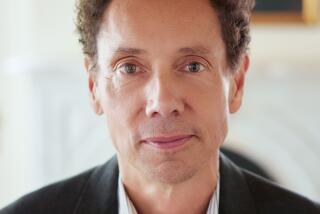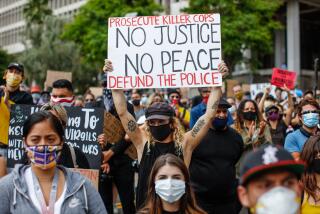Itsy-Bitsy
- Share via
The difference between flowing water and solid ice is one degree of temperature. A two-ton truck perched on a cliff can be demolished with the push of a forefinger. Are there parallel situations in society? Can tiny changes turn a thriving neighborhood into a slum or a losing political campaign into a winner?
Over the last three decades, a few social scientists have been suggesting as much, and journalist Malcolm Gladwell brought the idea of “tipping points” to public attention in a 1996 article in the New Yorker, out of which this book grew. With passion and eloquence, he argues for the proposition that minor alterations, if carefully conceived and adeptly enacted, can produce major consequences for individuals, organizations and communities. Gladwell devotes most of the book to examples of enterprising people and projects that illustrate his thesis, which potentially has momentous implications. To make a big difference, policymakers need not create big, expensive programs. On the contrary, they should focus on little things that can have a huge impact.
But though tipping point theory is certainly tantalizing, it suffers from a not-so-tiny handicap. Only scant support for the theory can be found in actual studies by social scientists and, contrary to the impression that Gladwell gives, the evidence that does exist is far from conclusive.
Take a centerpiece of Gladwell’s argument in both his magazine piece and his book--the so-called “broken windows” approach to crime reduction. Popularized initially by James Q. Wilson and George Kelling in a 1982 article in the Atlantic Monthly and embraced by New York Mayor Rudolph Giuliani, the doctrine holds that by cracking down on minor disturbances, police can transform a disorderly environment, in which crime thrives, into an orderly environment in which it does not.
Barry Glassner is the author of “The Culture of Fear: Why Americans Are Afraid of the Wrong Things.” He is a professor of sociology at USC.
To hear Gladwell tell it, one of the basic hypotheses of “broken windows” theory has been borne out in New York City. He writes, “Clean up graffiti and all of a sudden people who would otherwise commit crimes suddenly don’t.” But the evidence to support this assumption is not so clear. A temporal connection certainly exists (after transit police rid the subways of graffiti, sure enough, crime went down), but a causal connection is much harder to nail down. Research by sociologists and criminologists has identified a legion of factors that contributed to the drop in crime in New York: an increase in the number of police officers, a decrease in the number of young males in their late teens and early 20s, an improving economy, longer jail sentences for hard-core criminals, declining sales of crack cocaine and the violence associated with drug trade and what some researchers dub the “little-brother syndrome.” During the 1980s, a great deal of violent crime was concentrated in inner-city neighborhoods. Studies find that in some of those areas, significant numbers of young boys saw the consequences of older boys’ actions and opted not to follow in their footsteps to prisons or graveyards. Crime rates came down when the younger boys reached the peak age for involvement in crimes.
Disciples of the broken windows doctrine, Gladwell among them, play down the significance not only of all these factors that complicate their tidy theory of what “tips” the crime rate but also the theory’s adverse consequences when put into practice. Policies that crack down on people who commit minor crimes can be costly, to both taxpayers and to suspects. Between 1993 and 1996, the number of misdemeanor arrests in New York increased by 50%, and so did the number of complaints of police brutality. As a rule, the targets of the heightened surveillance and harassment were poor and minority youths.
In fact, the anti-graffiti campaign was a mixed blessing. Prior to the crackdown, young people had been doing more than merely tagging gang names on walls and subway trains. Some had produced huge murals that required many hours of work and considerable skill. Devotion to that activity deflected some young New Yorkers from gangs, according to Joe Austin of Bowling Green University, who interviewed more than 100 graffiti artists and studied the products of their labors. Austin’s research suggests that the crackdown had little or no effect on crime rates and, by targeting muralists as well as taggers, banished an important underground art form.
Anyone advancing a tipping-point theory must establish, at a minimum, that a particular effect is nonlinear, meaning that it did not result from the cumulative outcome of a string of events, like an automobile produced on an assembly line, but rather from one event that becomes decisive. In the physical world, nonlinearity is fairly common. Examples range from the relatively simple--such as water turning to ice--to the more complex--like the human body developing an addiction.
It is not surprising that the most effective chapter in “The Tipping Point” concerns one of these physiological phenomena--the mystery of why nicotine, a highly addictive substance, is, as the author puts it, “only addictive in some people, some of the time.” Gladwell points out that, contrary to a popular misconception, millions of people smoke regularly without getting hooked.
A body of medical evidence supports Gladwell’s contention that the reason lies in the nonlinearity of addiction. “It’s not that if you need one cigarette a day you are a little bit addicted, and if you need two cigarettes a day you are a little bit more addicted,” he notes. Rather, each of us has a nicotine threshold beyond which we become addicted. If my threshold is five cigarettes a day and I limit myself to four, I avoid addiction.
The tipping point for nicotine addiction is different for each person. From this fact, Gladwell rightly adduces an important policy proposal: We are more likely to prevent young people from becoming cigarette addicts by reducing the level of nicotine in cigarettes than by preaching at them. Nothing that adults say is likely to change the minds of rebellious adolescents, but we can regulate tobacco products to protect their bodies from addiction.
For problems rooted principally in society rather than in physiology, however, clear instances of nonlinearity are hard to find, and so are ready remedies. Gladwell mentions briefly what may be the best candidate to date. A decade ago, Jonathan Crane, a sociologist at the University of Illinois, showed that when the number of managers, teachers and other professionals living in poor neighborhoods drops below 5%, there is a dramatic increase in the number of high school dropouts and pregnant teens. Crane’s statistical analysis in support of that conclusion withstood rigorous peer review, and his research appeared in preeminent scholarly journals.
Yet even Crane’s study has its critics. Other researchers have looked for nonlinear effects on teenage childbearing and graduation but have not found them. And contrary to Gladwell’s contention that it is the loss of positive roles models that produces sudden upturns in childbearing and dropping out, research reveals a more complex picture. By the time professionals have vacated a community, so have other incentives for staying in school and postponing pregnancy. Job opportunities, stable households and community organizations have become rare as well.
That Gladwell fails to build a viable sociological theory reveals more about the paucity of materials available to him than it does about his talents as a social analyst. The author of some of the most penetrating essays of our age, on topics that run from the flu epidemic of 1918 to contemporary fashion trends, Gladwell simply cannot, in “The Tipping Point,” overcome the absence of scientific evidence required to answer some fundamental questions. Although he repeatedly avows that “a small change is often all it takes” to make a big difference, he fails to define which sorts of modest changes possess that capacity.
*
To be sure, Gladwell tosses out loads of examples of successful tinkering. He describes, for instance, how the addition of a campus map on a brochure encouraging Yale University students to get tetanus shots substantially raised the vaccination rate and how Columbia Record Club increased sales by adding to its advertising a little gold box that offered a free record. Gladwell labels these minor alterations that heighten the impact a message has on an audience the Stickiness Factor. He never spells out, however, the characteristics that make something sticky--why a map and a gold box have such selling power when other equally small and inventive gambits do not. Imagine if a physicist explained how liquids become solids by means of something called the Coldness Factor. The explanation would be of little value unless, at a minimum, the scientist specified which liquids respond (water but not oil, lakes but not oceans) and how much coldness is required.
So it is with social scientific explanations. Intriguing instances, nifty concepts, and ex post facto explanations do not a theory make.
More to Read
Sign up for our Book Club newsletter
Get the latest news, events and more from the Los Angeles Times Book Club, and help us get L.A. reading and talking.
You may occasionally receive promotional content from the Los Angeles Times.






